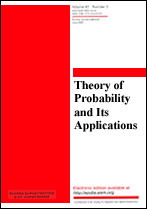|
This article is cited in 21 scientific papers (total in 21 papers)
Short Communications
On the maximum correlation coefficient
W. Bryca, A. Dembob, A. Kaganc
a University of Cincinnati, Department of Mathematical Sciences
b Stanford University
c University of Maryland
Abstract:
For an arbitrary random vector $(X,Y)$ and an independent random
variable $Z$ it is shown that the maximum correlation coefficient
between $X$ and $Y+\lambda Z$ as a function of $\lambda$ is lower semicontinuous
everywhere and continuous at zero where it attains its maximum. If, moreover,
$Z$ is in the class
of self-decomposable random variables, then the maximal
correlation coefficient is right continuous,
nonincreasing for $\lambda\geqslant 0$ and
left continuous, nondecreasing for $\lambda \leqslant 0$.
Independent random variables $X$ and $Z$ are Gaussian if and only if the maximum
correlation coefficient between $X$ and $X+\lambda Z$ equals the linear
correlation between them. The maximum correlation coefficient between the sum of $n$
arbitrary independent identically distributed random variables and
the sum of the first $m<n$ of these equals $\sqrt{m/n}$ (previously
proved only for random variables with finite second moments, where it
amounts also to the linear correlation).
Examples provided reveal counterintuitive behavior of the maximum correlation
coefficient
for more general $Z$ and in the limit $\lambda \to \infty$.
Keywords:
dependence, maximum correlation, self-decomposable random variables.
Received: 01.04.2003
Citation:
W. Bryc, A. Dembo, A. Kagan, “On the maximum correlation coefficient”, Teor. Veroyatnost. i Primenen., 49:1 (2004), 191–197; Theory Probab. Appl., 49:1 (2005), 132–138
Linking options:
https://www.mathnet.ru/eng/tvp246https://doi.org/10.4213/tvp246 https://www.mathnet.ru/eng/tvp/v49/i1/p191
|


| Statistics & downloads: |
| Abstract page: | 509 | | Full-text PDF : | 182 | | References: | 58 |
|




 Contact us:
Contact us: Terms of Use
Terms of Use
 Registration to the website
Registration to the website Logotypes
Logotypes








 Citation in format
Citation in format 
